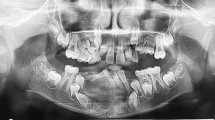Abstract
“Hair-on-end” skull changes are typically seen in individuals suffering from thalassaemia. They are induced by widening of the diploic space due to marrow expansion that is a consequence of ineffective and excessive erythropoiesis. We present a child with severe congenital neutropenia who exhibited the typical hair-on-end sign on plain skull radiographs and MRI. In this patient the skull changes were very likely induced by the expansion of white blood cell precursors induced by long-term daily injections of recombinant human granulocyte colony stimulating factor (G-CSF) to treat his confounding disease. This case report is the first description of hair-on-end changes associated with the use of G-CSF.



Similar content being viewed by others
References
Orzincolo C, Castaldi G, Scutellari PN et al (1989) The “lamellated” skull in beta-thalassaemia. Skeletal Radiol 18:373–376
Hollar MA (2001) The hair-on-end sign. Radiology 221:347–348
Walor DM, Berdon WE, Westra SJ (2005) ‘Hair-on-end’ skull changes resembling thalassemia caused by marrow expansion in uncorrected complex cyanotic heart disease. Pediatr Radiol 35:698–701
Moseley JE (1974) Skeletal changes in the anemias. Semin Roentgenol 9:169–184
Williams AO, Lagundoye SB, Johnson CL (1975) Lamellation of the diploe in the skulls of patients with sickle cell anaemia. Arch Dis Child 50:948–952
Zeidler C, Welte K (2002) Kostmann syndrome and severe congenital neutropenia. Semin Hematol 39:82–88
Cottle TE, Fier CJ, Donadieu J et al (2002) Risk and benefit of treatment of severe chronic neutropenia with granulocyte colony-stimulating factor. Semin Hematol 39:134–140
Dale DC, Person RE, Bolyard AA et al (2000) Mutations in the gene encoding neutrophil elastase in congenital and cyclic neutropenia. Blood 96:2317–2322
Rosenberg PS, Alter BP, Bolyard AA et al (2006) The incidence of leukemia and mortality from sepsis in patients with severe congenital neutropenia receiving long-term G-CSF therapy. Blood 107:4628–4635
Cristy M (1981) Active bone marrow distribution as a function of age in humans. Phys Med Biol 26:389–400
Author information
Authors and Affiliations
Corresponding author
Rights and permissions
About this article
Cite this article
Albert, M.H., Notheis, G., Wintergerst, U. et al. “Hair-on-end” skull induced by long-term G-CSF treatment in severe congenital neutropenia. Pediatr Radiol 37, 221–224 (2007). https://doi.org/10.1007/s00247-006-0363-3
Received:
Revised:
Accepted:
Published:
Issue Date:
DOI: https://doi.org/10.1007/s00247-006-0363-3




